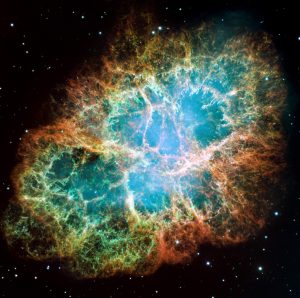The type of a supernova is determined from its observed spectral lines. Type I supernovae have absolute magnitudes of up to -19.5 and their spectra reveal strong lines of iron. They have no hydrogen and are of uniform size and luminosity. If silicon lines are detected then it is sub-categorised as a Type Ia. If there are no silicon lines then it is either a Ib or Ic: Ib if there are helium lines; Ic if there are no helium lines.

Type Ia Supernova
A Type Ia supernova involves a variable star with a white dwarf companion— a binary star system. The white dwarf is an extremely dense carbon-oxygen remnant. Because of its extreme gravitational pull it gradually strips the bigger companion of material until the pressure becomes so intense that the process triggers a thermonuclear explosion on its surface.
If the remnant is no more than 1.4 solar masses and has no companion on which to feed then it will become a stable white dwarf. An example is Sirius B which is roughly one solar mass but with a diameter only twice that of Earth. Its surface temperature is 100 000°C. It will gradually fade over hundreds of millions of years to become a black dwarf.
Type Ib and Type Ic
Type Ib and Type Ic are “stripped core collapse supernovae”. They occur in populations of massive stars, similar to Type II. They primarily take place in Wolf-Rayet stars that have shed substantial mass from their outer layers. There is no indication of silicon in their spectra. However, the chief difference between the two is that Type Ib also has helium. Type Ic has no helium.
These supernovae involve stars of at least 25 solar masses.
Type II Supernova
Type II supernovae have a much broader maxima in their light curves than Type I. Their spectra are similar to those of novae, which are characterised by hydrogen emission lines. Type II vary enormously in size and luminosity. The fading after maximum is rapid but this eventually slows down, and after about 60 days there is a steady decline in brightness.
The absolute magnitudes of Type II supernovae can reach -16 to -18. The Crab Nebula was probably formed from a Type II supernova.
To become a Type II supernova a star must have collapsed to a size equal to a solar mass of eight or more. No surprise they do not spend much time in the main sequence before expanding to red giants. When silicon fusion produces iron in the core the speed of the reaction accelerates so that within just one day the iron core alone exceeds the Chandrasekhar limit, and a complete collapse of the star occurs. The density reaches such a point that a gigantic shockwave rebounds, and all the matter is blasted out into space at speeds of between 30 000 and 50 000 kilometres a second.
Another limit determines whether the collapsed material will become a neutron star or a black hole. This limit is around 3 solar masses after the final collapse: below this, the material crushes down to a neutron star; above this limit the gravitational forces are just so extreme that not even light can escape and the star seems to disappear—a black hole.
Type II supernovae are sometimes called a “core collapse supernova” (similar to Type Ib and Ic). They occur in stars with masses up to 40 to 50 solar masses. This diagram plots the pathways to destruction.

Hypernova
A hypernova (sometimes labelled a Type III supernova) develops from monster stars with core masses from 5 to 15 solar masses. They collapse to form black holes at their centres. Gravitational forces are so intense that the core consumes the outer layers of the star even while it is exploding. The energy released from such a massive dying star amounts to a brightness 10 to 20 times that of a normal supernova.
As with a supernova, sub-atomic particles called neutrinos are produced. They travel so fast—at almost the speed of light—that they even outrun the explosion that set them off.
This type of supernova leaves nothing behind. An example is Hypernova 2006gy, typical of the first stars that seeded the universe. They are the largest iron factories of the universe (150 times the mass of the Sun).
Back to Top
By Nigel Benetton, science fiction author of Red Moon Burning and The Wild Sands of Rotar.
Last updated: Saturday, 20 March 2021